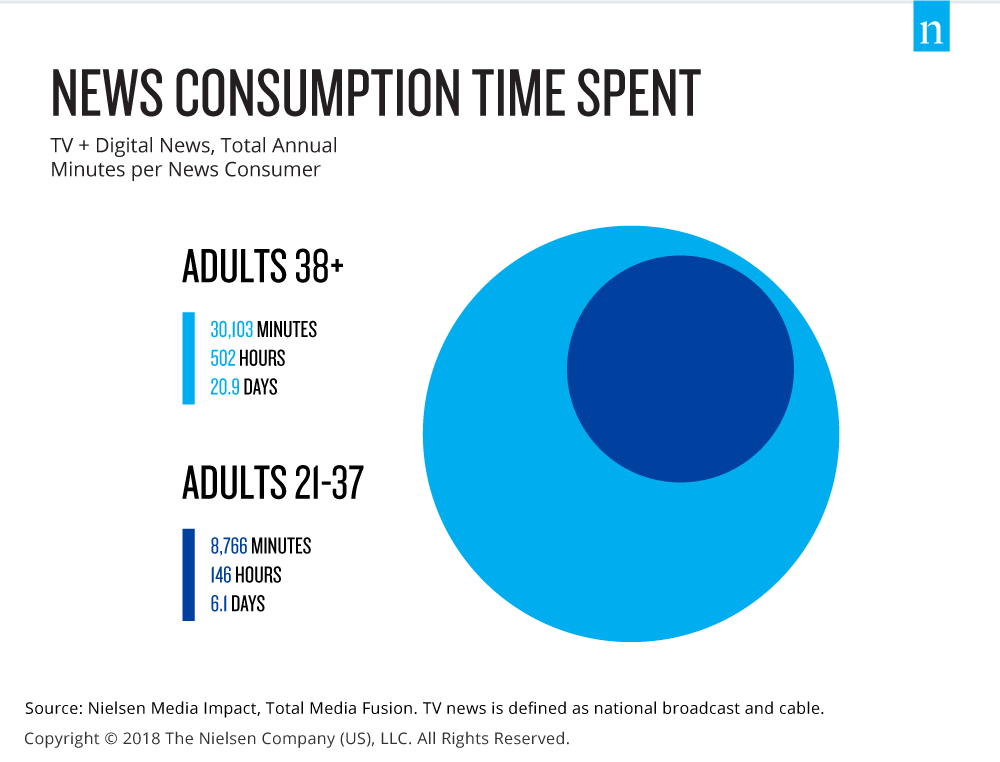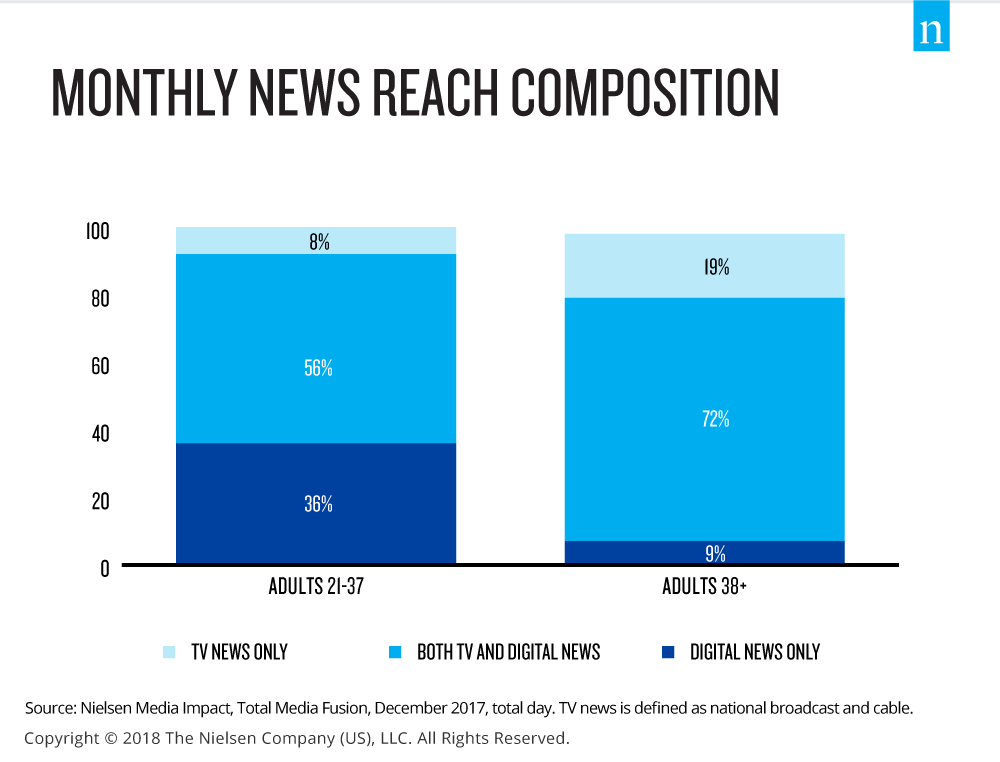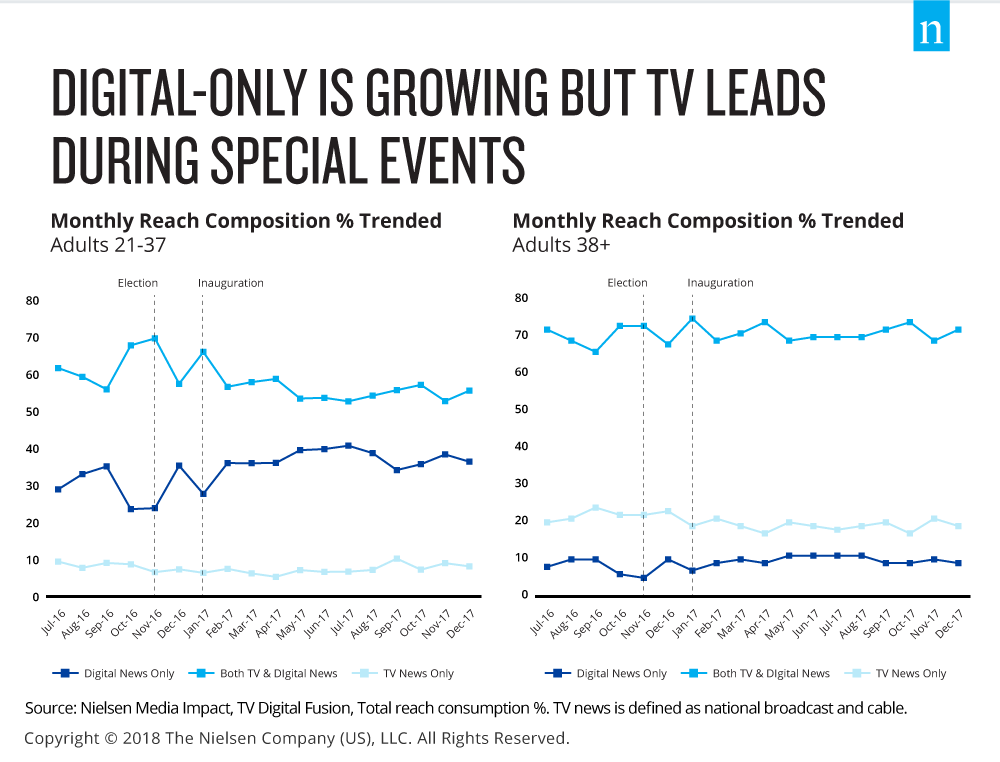Millennials, defined here as adults ages 21-37, are the most-coveted consumer demographic from a marketer-engagement perspective, yet they’re often the most stereotyped as well. This generation has spending power and influence, and marketers are eager to reach them.
The current media landscape in the U.S. is fragmented, resulting in multiple ways for people to consume news and current events. Our media consumption continues to expand and this year, U.S. adults currently spend over 11 hours a day with media. That’s up from what we saw a year ago. Not surprisingly, our news appetite continues to grow in step with overall media consumption, and Millennials are no strangers to news, which reaches 95% of this demographic and 99% of those 38 and older. However, the older demographic spends three times longer engaging with national news in a year than Millennials.

Despite the difference in time spent with total news, when looking at digital news, both generations consume news on mobile devices equally. Mobile is driving digital news consumption, reaching 30% more digital news consumers than desktop, and a third of Millennial news viewers are reached only by digital news.

In looking at the digital consumption of digital-first and national TV news, we see that higher reach doesn’t guarantee lengthy engagement. Notably, the reach of digital-first news among both generations is higher than TV news on digital, yet both groups of consumers spend significantly less time with digital-first news than TV news on digital.
Digital-First News is a Preferred Format
Compared with cable news, broadcast news, and even late-night comedy, digital-first news performed better in every category that was tested in an online controlled exposure test conducted at the Nielsen Media Lab to better understand hard to measure differences between several categories of news programming.
Digital reported the highest scores across categories for both generations, but the other formats had bright spots, too. Cable news resulted in some of the highest scores for adults 38-64, as they are likely to trust these programs and find them to be very credible sources. Like Millennials, adults in this age range also feel connection and excitement to the main topic when watching cable news. When viewing broadcast TV, this viewing demographic increases comprehension to their highest levels.
Additionally, the Media Lab study focused on late night shows as a source for news. Millennials feel like they learn more information or increase their knowledge on the topics they are watching more so than adults 38-64. They are also much more likely to want to take action or be open to changing their opinion as a result of viewing late night clips. Millennials also score higher in trust and enjoyment, especially in excitement around the main topic they are viewing.
Breaking News on TV Holds Attention
The reach of digital news among Millennials is growing, but that doesn’t mean that national TV isn’t a key component in this ecosystem. The data actually shows that Millennials are dramatically influenced to tune in to TV during breaking news moments, even more so than adults 38 and older. When looking at monthly reach trended for Millennials, there are spikes in both TV and digital news during special events, such as the 2016 Presidential Election and the Presidential Inauguration in January 2017. Millennials continue to look toward digital news during these events but also tune into TV for supplemental information.

Out-of-Home Viewing Provides a Significant Lift
Out of home viewing is also popular with Millennials. In fact, Millennial’s share of incremental out-of-home (OOH) TV viewing for news, as compared to national in home viewing, nearly tripled 7% to 19%. Overall, 24% of all OOH viewing comes from Millennials. That’s 8% higher than national in-home viewing for this demographic segment. What’s more impressive is that for Millennials, the share of incremental OOH viewing for news, as compared to national in-home viewing, nearly tripled.
For additional insights, download our latest Millennials on Millennials report, which focuses on news consumption habits.
Methodology
The insights in this article were derived from the following sources:
- The latest “Millennials on Millennials Report,” which was developed by Nielsen Millennial associates. This report analyzes the unique nature of this demographic group by leveraging Nielsen data sets and fielding a custom survey to understand the "whys" behind the data trends.
- Nielsen Media Impact
- The Q1 2018 Nielsen Total Audience Report
- An online controlled exposure test conducted by the Nielsen Media Lab, which helps to better understand hard to measure differences between several categories of news programming. Each news category had five, 10-minute long clips of their typical content, except cable news which had 15 clips.



